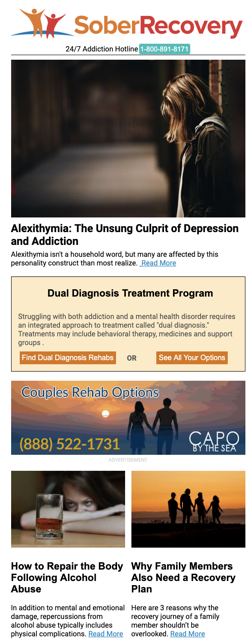Unique Characteristics of Various Types of Eating Disorders York PA
Substance abuse , Detoxification
Types of Care
Residential short-term treatment (30 days or less)

York, PA
Substance abuse
Types of Care
Outpatient
Language Services
ASL or other assistance for hearing impaired, Spanish

Substance abuse
Types of Care
Outpatient

Substance abuse
Types of Care
Outpatient
Language Services
Spanish

Substance abuse
Types of Care
Residential short-term treatment (30 days or less), Residential long-term treatment (more than 30 days), Outpatient
Special Programs/Groups
DUI/DWI offenders

Substance abuse
Types of Care
Outpatient
Special Programs/Groups
Women, Criminal justice clients

Substance abuse
Types of Care
Residential long-term treatment (more than 30 days)
Special Programs/Groups
Adolescents, Gays and Lesbians, Criminal justice clients

(717) 851-5320
Services Provided
Substance abuse , Detoxification
Types of Care
Outpatient
Special Programs/Groups
Persons with HIV/AIDS, Gays and Lesbians, Women, Men, DUI/DWI offenders
Language Services
ASL or other assistance for hearing impaired

(717) 632-4900
Services Provided
Substance abuse
Types of Care
Outpatient

Substance abuse
Types of Care
Outpatient, Partial hospitalization/day treatment
Special Programs/Groups
DUI/DWI offenders


Unique Characteristics of Various Types of Eating Disorders
We are almost recognizable with the three major disorders such as Anorexia Nervosa, Bulimia Nervosa and Binge Eating Disorder although there are many different types of eating disorders. About millions of people are affected by Prader–Willi Syndrome and Night Eating Syndrome; these are some of the minor disorders. This is a short list of both major and minor eating disorders describing symptoms and treatment.Bigorexia (Muscle Dysmorphia)
Typically seen in men, especially bodybuilders or weight lifters, bigorexia is a body image disorder where the person feels their body is too small. Therefore, they spend excessive hours at the gym working out. Sometimes seen as the “reverse anorexia” However, no matter how big or muscular a person becomes they still feel their bodies are too small. There are no true symptoms of bigorexia other than a person’s excessive attention to body image. Bigorexia is rarely diagnosed because; it is socially acceptable for men to be muscular. Bigorexia may not be as life threatening as anorexia, but it does have dangers. Many people with the disease are prone to steroid abuse and in extreme cases; the disorder may affect the person’s work and personal life.
Binge Eating Disorder (Compulsive Overeating)
A person with binge eating disorder will compulsively overeat without throwing–up, abusing laxatives or excessively exercising to compensate for the large amounts of food they’ve just consumed. According to the National Eating Disorder Association so...
Click here to read the rest of this article from Sober Recovery
Featured Facilities
Choosing the right treatment center can be paramount in one’s chance at recovery. While the treatment facility creates a foundation of tools needed for recovery, it is truly the individual, and not the addiction treatment center that determines the end result. When it comes to yourself or a loved one, you are going to want to make sure to choose a facility that has professional accreditations. Located in the Atlanta, Georgia area, Southeast Addiction Center ensures each client receives the tools needed to live a life without addictive substances.From individual therapy to group therapy, to trauma-based therapy and 12-step support, our clients learn how to find their own strength as well as create a support system around them. The transition from addiction to sobriety can be hard, however, at our drug and alcohol rehabilitation program, we guide each client through the process – step by step.
Lake Ariel Recovery Center, like all of the Sanctuary Health Group facilities, is a medically proven recovery facility that provides comprehensive treatment for substance use and co-occurring disorders. Sanctuary Health utilizes Everlasting Recovery, an approach that aligns our client’s recovery journey directly with their life, to extend recovery into a client’s lifestyle. Our unique approach establishes treatment as a daily practice, refocuses an individual away from addiction towards a healthier existence, and makes sustainable recovery achievable. Due to this integration, each client begins Everlasting Recovery by assessing their performance in various aspects of their lives via the bio, psycho, and social model. This initial assessment allows our therapists to craft a personal recovery program, which allows the greatest opportunity for our clients to suppress addiction and adopt recovery as a permanent identity. When attending Lake Ariel Recovery Center, our clients will establish life skills, implement daily routines for lifestyle recovery, and ignite a purpose for achieving better their lives. Through accomplishing these tasks, our clients will achieve sustainable recovery.
Compassionate care for individuals with opioid and alcohol use disorders. Substance use disorders are a leading cause of death, incarceration, hospitalizations, motor vehicle crashes, and numerous medical complications such as hepatitis C and HIV. We are passionate about recovery, and strive to help each patient achieve their own recovery from substance use disorders is a lifelong journey which begins with education, medical optimization, and accountability.We are proud to serve Texas as the Top Houston Suboxone Doctor and the surrounding areas with In-Office and Virtual Visit Appointments! He provides Concierge-level compassionate care for individuals with Opioid and Alcohol Use Disorders and believes treatment for addiction works to help individuals maintain long-term abstinence and recovery.With Dr. Giannotti, appointments are zero-wait, always on time as he specializes in services and treatments such as:- Anxiety treatment- Depression treatment- Insomnia treatment- Medication Assisted Treatment (MAT)Sometimes the smallest step in the right direction ends up being the biggest step in one's life. Tip Toe if you must, but Dr. Giannotti is here to take the step beside you.
Located in Orange County, California, Connections Mental Health is a residential treatment center that focuses on treating a range of mental health conditions. It treats a maximum of 6 clients at a time to create individualized care. With compassion at the core of its approach, the team provides a comprehensive evaluation before treatment to customize clients’ care plans to meet a diversity of needs.Mental Health Treatment Connections Mental Health can help those with depression, anxiety, post-traumatic stress disorder (PTSD), bipolar disorder, borderline personality disorder (BPD), obsessive-compulsive disorder (OCD), schizophrenia, attention-deficit/hyperactivity disorder (ADHD), and suicidal and homicidal ideation. Connections Mental Health additionally has a 24/7 supervised eating disorder program backed by a team of psychiatrists, psychologists, dietitians, and medical doctors. They offer a special program for people with premenstrual dysphoric disorder (PMDD).Comprehensive TherapiesConnections Mental Health uses 1:1, group, and family-based therapy (FBT) to help clients recover. FBT restores healthy habits and builds open communication within the family. They offer evidence-based therapies such as cognitive behavioral therapy (CBT), dialectical behavioral therapy (DBT), eye movement desensitization and reprocessing (EMDR), and motivational interviewing. Connections Mental Health offers medication management based on their clinical assessment. They incorporate the Seeking Safety program into treatment. Seeking Safety creates a safe space to develop coping skills, emotion regulation, and resilience through therapies that focus on healing current feelings and behaviors, not past ones.Holistic HealingConnections Mental Health utilizes holistic tools as part of their rehab process like yoga, mindfulness, and meditation, and other modalities like art therapy, to complement the recovery process. These therapies can help clients develop coping strategies, reduce stress, and improve overall well-being. Connection Mental Health’s Orange County residential home has a backyard with comfortable seating and a firepit.




